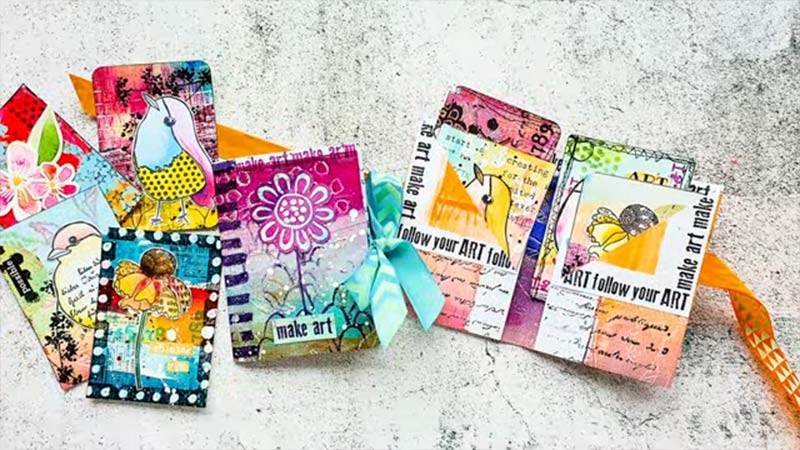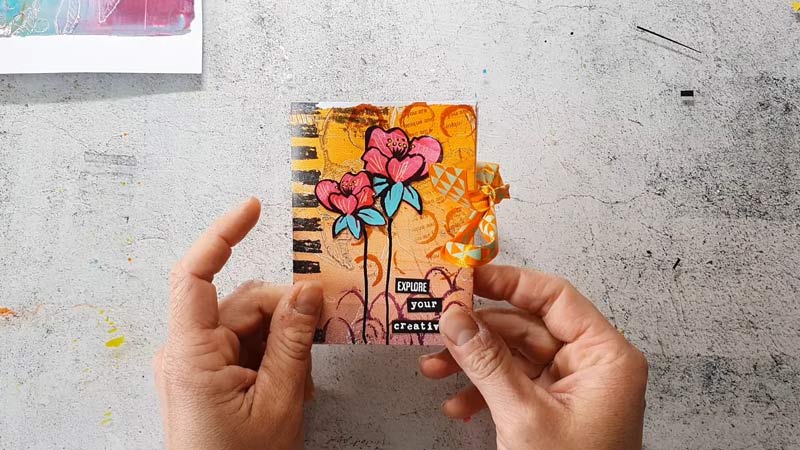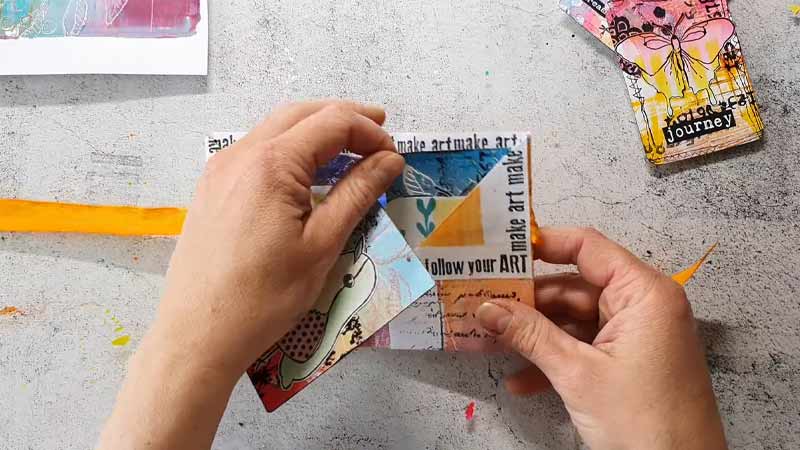In paper crafting, there exists a unique and artistic form known as ATC, or Artist Trading Cards. These small, exquisitely detailed pieces of art have gained immense popularity among creative enthusiasts.
ATCs are not your traditional greeting cards; instead, they serve as miniature canvases for artists and crafters to unleash their creativity.
Measuring just 2.5 x 3.5 inches, these tiny treasures offer a world of creative possibilities, often adorned with intricate designs, paintings, collages, and more.
But ATCs are more than just artistic expressions; they’re a means of connecting with fellow creators through swaps and collaborations, fostering a vibrant and interconnected community of paper crafting enthusiasts.
In this exploration, we delve into the captivating realm of ATCs and their significance in the world of paper crafting.

What Is ATC in Paper Crafting?
ATC, or Artist Trading Cards, are a fascinating and popular subset of paper crafting. These miniature works of art, typically measuring just 2.5 x 3.5 inches, serve as a creative outlet for artists and crafters.
Unlike traditional trading cards, ATCs are not bought or sold; they are exchanged or traded among artists, hence the name “trading cards.”
ATCs are known for their intricate and diverse designs. Artists use various techniques such as painting, drawing, collage, stamping, and embellishments to decorate these small canvases. Each ATC is a unique piece, showcasing the creator’s style, skill, and artistic vision.
These tiny cards have gained a devoted following and are often traded in person, at crafting events, or through online communities.
The act of trading ATCs fosters connections among artists, allowing them to share ideas and techniques while building a sense of camaraderie.
In essence, ATCs are a testament to the boundless creativity that paper crafting offers. They provide a platform for self-expression, artistic exploration, and community building within the ever-evolving world of paper crafting.
Why Are Artists Trading Cards Valuable?

Artist Trading Cards (ATCs) are small, original pieces of art created by artists and traded or exchanged among artists and collectors.
The value of ATCs can vary depending on these factors:
Artistic Skill
The value of an ATC often hinges on the level of skill and creativity demonstrated by the artist. ATCs that showcase exceptional technical proficiency, innovative techniques, and a distinctive style are more likely to be sought after by collectors who appreciate fine artistry.
Rarity
ATCs are typically produced in limited quantities, frequently as one-of-a-kind pieces. This scarcity can make them more valuable, especially when an artist rarely creates ATCs or when a specific card is unique in some way, such as being the artist’s first or last in a series.
Collectibility
ATC collectors often seek cards to build a comprehensive collection. Some may have a preference for cards from specific artists, themes, or series. This demand can drive up the value of ATCs that fit into these sought-after categories.
Artist Reputation
The reputation of the artist can significantly impact the value of their ATCs. Well-established and renowned artists often command higher prices for their work due to their status in the art world and the prestige associated with owning one of their ATCs.
Uniqueness
ATCs are celebrated for their individuality. Artists frequently use these small canvases to experiment with various mediums, styles, and concepts. Collectors may place a premium on ATCs that stand out as unique or particularly innovative.
Trading and Networking
The social aspect of ATC trading and networking can’t be underestimated. Artists and collectors often form close-knit communities, and the history of a card’s ownership and trades can add to its appeal and value.
Historical Significance
Some ATCs become historically significant due to their association with particular art movements, events, or time periods.
These cards can become valuable artifacts for art historians and collectors interested in preserving cultural and artistic history.
Personal Connection
Personal connections to an artist or the emotional resonance of an ATC can elevate its value. Collectors might cherish cards that remind them of meaningful experiences or that align with their personal tastes and interests.
Packaging and Presentation
How an ATC is presented can enhance its perceived value. Cards that come with certificates of authenticity, professional framing, or unique packaging may be considered more valuable by collectors who appreciate these added touches.
Auctions and Resale
ATCs can be sold at art auctions or on the secondary market. Competitive bidding and high demand can lead to significant price increases, especially when collectors are vying for rare or highly coveted cards.
Are Aceo Cards Worth Anything?

ACEO stands for “Art Cards, Editions and Originals.” These are collectible, small-format artworks typically measuring 2.5 x 3.5 inches, the same size as standard trading cards.
ACEO cards are created by artists and are often sold, traded, or collected by art enthusiasts.
Whether ACEO cards are worth anything depends on several factors:
Artistic Quality
The primary determinant of an ACEO card’s value is the quality of the artwork. Exceptional skill, creativity, and craftsmanship can make an ACEO card more valuable to collectors.
Artist Reputation
ACEO cards created by well-known or highly respected artists within the art community may command higher prices due to the reputation and recognition of the artist.
Medium and Technique
The materials and techniques used by the artist can also affect the value of ACEO cards. For example, cards created using rare or high-quality art supplies may be considered more valuable.
Rarity
Limited edition ACEO cards or one-of-a-kind originals tend to be more valuable than mass-produced or readily available cards. Rarity can be driven by factors such as the artist’s output, unique subject matter, or special techniques.
Collectibility
Some collectors specifically seek out ACEO cards, either because they appreciate the art form or because they collect works from specific artists or themes. Demand within the collector community can drive up the value of certain ACEO cards.
Historical Significance
ACEO cards may gain historical significance if they are associated with a particular art movement, event, or period. Such cards can become valuable artifacts for collectors and researchers.
Personal Connection
Collectors may value ACEO cards for personal reasons, such as a connection to the artist or the emotional impact of the artwork. These personal connections can influence the perceived value of an ACEO card.
Market Trends
Like any collectible item, the value of ACEO cards can be influenced by market trends. If there is a surge in demand for ACEO cards, prices may rise.
Packaging and Documentation
The way an ACEO card is presented, including whether it comes with a certificate of authenticity or other documentation, can affect its perceived value.
Artist Trading Cards Ideas

Creating Artist Trading Cards (ATCs) offers a wonderful opportunity for artistic expression and creativity.
Here are some ideas to inspire your ATC projects:
Miniature Portraits
When creating small portraits on ATCs, the challenge lies in capturing the essence of the subject with limited space.
Focus on conveying emotions through facial expressions, highlighting unique features, and paying attention to details like eyes, lips, and hair. The small format encourages artists to practice precision and subtlety in their work.
Nature and Botanicals
ATCs dedicated to nature and botanical themes can be a delightful exploration of the natural world.
Experiment with various media, such as watercolors, colored pencils, or acrylics, to depict flowers, plants, insects, or landscapes. Emphasize texture and depth to make your subjects come alive on the small canvas.
Abstract Art
Abstract ATCs allow artists to express themselves freely through shapes, colors, and concepts. You can create bold and dynamic compositions using techniques like splattering, dripping, or layering.
Embrace geometric patterns or mix different media, such as acrylics and collage elements, to achieve unique and visually striking abstract designs.
Collage and Mixed Media
Collage and mixed media ATCs offer endless possibilities for creativity. Combine materials like newspaper clippings, fabric swatches, buttons, or even found objects like keys or postage stamps to create textured and visually rich artworks.
Experiment with layering and juxtaposition to convey your artistic vision.
Fantasy and Sci-Fi
For fans of fantasy and science fiction, ATCs provide a canvas to bring otherworldly realms to life. Illustrate mythical creatures, dreamy spacescapes, or iconic scenes from beloved books, movies, or video games.
Use your imagination to craft imaginative and captivating narratives within the confines of the small format.
Watercolor Washes
Watercolors are perfect for creating ethereal and dreamy backgrounds on ATCs. Apply soft, flowing washes of color to set the mood or atmosphere.
After the washes dry, you can add finer details with pens, pencils, or ink to complete your artwork.
Mosaics
Replicating the intricate beauty of mosaic art on ATCs can be a rewarding challenge. Cut and arrange small pieces of colored paper or other materials to create intricate patterns and designs.
This technique can result in visually captivating and tactile artworks that resemble traditional mosaic art.
Mini Landscapes
Miniature landscapes, whether of serene countryside scenes, breathtaking seascapes, or bustling cityscapes, invite exploration of perspective and mood.
Use the small canvas to your advantage, focusing on capturing the essence of a specific time of day or season while experimenting with perspective techniques.
Ink and Doodles
Creating intricate ink drawings on ATCs is an exercise in fine detail and precision. Use fine lines to craft elaborate patterns, intricate doodles, or zentangle-inspired designs. Incorporating hatching or cross-hatching can add depth and texture to your inked creations.
Monochromatic Themes
Exploring monochromatic themes on ATCs is an exercise in subtlety and tone. Choose one or two hues and explore the full range of shades and tones within that color palette. This approach can lead to elegant and harmonious compositions.
Quilling
Quilling is a delicate and intricate art form that involves rolling and shaping strips of paper into various shapes and designs.
When applied to ATCs, quilling can add a unique three-dimensional element to your cards. Create elegant patterns, floral motifs, or even abstract designs using colorful paper strips.
Art Nouveau and Art Deco
These iconic art movements from the late 19th and early 20th centuries are known for their elegant and decorative styles.
Channel the flowing lines, organic motifs, and intricate details of Art Nouveau or the geometric shapes and bold colors of Art Deco to create visually stunning and ornate ATCs.
Typography
Experiment with typography and lettering on your ATCs. Use different fonts and styles to convey meaningful quotes, messages, or words that resonate with you. Combine typography with illustrative elements or decorative flourishes for added visual impact.
Animal Kingdom
Whether you’re drawn to real animals or mythical creatures, the animal kingdom offers a rich source of inspiration for ATCs.
Create detailed and realistic depictions of your favorite animals or add a whimsical twist by giving them anthropomorphic qualities or placing them in imaginative settings.
Miniature Scenes
Craft miniature dioramas or scenes within your ATCs using small figurines, miniatures, or cutout elements.
These tiny scenes can tell a story, evoke a specific mood, or capture a moment in time. Consider using perspective and lighting techniques to enhance the realism of your miniatures.
Seasonal and Holiday Themes
Embrace the changing seasons or celebrate holidays by designing ATCs that capture the spirit and mood of specific times of the year.
Create festive ATCs for Halloween, Christmas, Valentine’s Day, or other holidays, incorporating relevant symbols, colors, and imagery.
Pop Culture
If you’re a fan of movies, TV shows, music, or pop culture icons, use your ATCs to pay homage to your favorites.
Feature famous characters, memorable quotes, or references that resonate with fans of these cultural phenomena. Your ATCs can become collectible pieces for fellow enthusiasts.
Texture and Layering
Experiment with different textures and materials to add depth and tactile interest to your ATCs. Incorporate sand, fabric, textured paper, or other materials to create visually rich and tactile surfaces.
Layering can also be achieved through collage techniques or by building up paint or other media.
Personal Journey
ATCs can serve as a canvas for personal expression and reflection. Use them to convey your own experiences, emotions, or reflections on significant life events. These deeply personal ATCs can be therapeutic and provide a meaningful outlet for self-expression.
Miniature Portfolios
Consider creating a series of ATCs that, when viewed together, tell a larger story or convey a specific theme.
This approach allows you to explore a concept or narrative in-depth, with each ATC contributing a unique perspective or element to the overall portfolio.
FAQS
What Kind of Paper is Used for ATCs?
ATC paper should be sturdy and durable to withstand various art techniques.
What is ATC Craft?
ATC craft refers to the creative process of making Artist Trading Cards (ATCs).
What’s the Origin of ATCs in Paper Crafting?
Artist Trading Cards (ATCs) originated in Switzerland in the late 1990s as a conceptual art project.
Are There Special Protective Sleeves for ATCs?
Yes, there are protective sleeves and pockets designed specifically for ATCs.
Are There ATC Collectors’ Clubs or Communities?
Yes, there are many ATC collectors’ clubs, online forums, and social media groups dedicated to this art form.
Can You Sell ATCs or Are They Exclusively for Trading?
While the primary spirit of ATCs is trading and sharing, some artists choose to sell their ATCs through various platforms, including art markets, online marketplaces, or their own websites.
Conclusion
ATC, or Artist Trading Cards, are small, intricate pieces of art within the realm of paper crafting. These miniature works of creativity serve as a platform for artists and crafters to express themselves, exchange ideas, and build a sense of community.
ATCs are not only a canvas for artistic exploration but also a means of connecting with like-minded individuals through swaps and collaborations.
Whether you’re a seasoned paper crafter or a novice looking to dive into this fascinating world, ATCs offer a delightful avenue to unleash your imagination, experiment with various techniques, and foster connections within the vibrant paper crafting community.
Leave a Reply